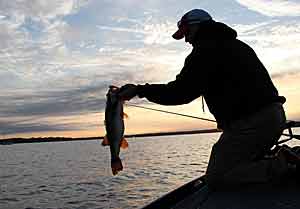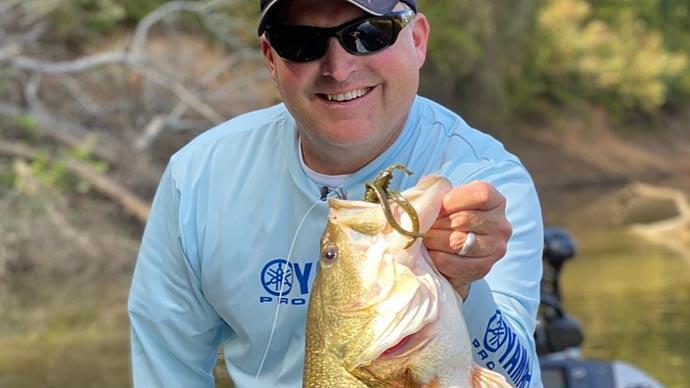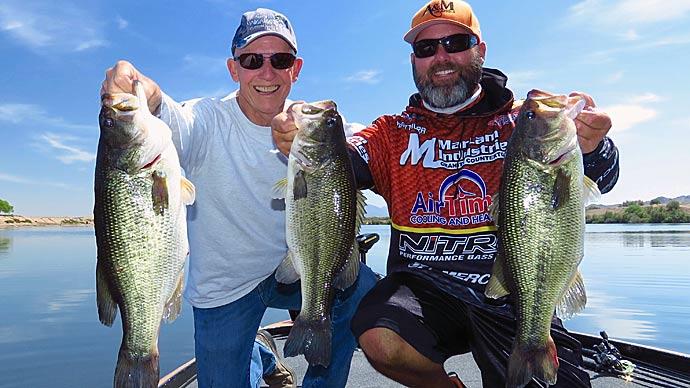
The following article is the first part of a series of tech articles focusing on how to increase your catch. This series will outline all tackle and methods to put you on to more fish. It is a small part of my approach catching more bass on a consistent level.
Every five years or so, it seems, a single bass technique comes along and revolutionizes the sport; tube fishing, Carolina rigs, Slider fishing, and split shotting, to name a few. These days drop shot or down shot fishing is getting any attention that the Senko isn't. Although not a new method, drop shotting has taken a firm hold on anglers and has manufacturers scrambling to build drop shot-only baits.
As I stated, drop shotting is not a new technique in principle. It dates back a long way in the saltwater circle. Although most drop fishing utilized a dropper loop rather than a hook tied directly to the main line, the idea of a weight below the bait is the way people have fished for flatfish for eons.
I remember fishing plugs for stripers with a teaser tied 14 inches above my diver. I tied a straight shank worm hook directly to the main line and set up a 4" Kalin's grub that often got the attention of a hungry striper.
As far as bass fishing is concerned, down shotting began in Japan years ago. You see, over there, water is at a premium. They have relatively few bodies of water. Small lakes see intense pressure with hundreds of anglers competing in tournaments. Anglers fish almost elbow-to-elbow in these deep clear waters. Drop shotting became the method of choice to catch these highly sought-after fish. Western Pro's like Don Iovino and Aaron Martens learned this method and began to perfect it on their home waters. A few significant tournaments have been won on it as well.
When you read about drop-shotting, you often see it as a great deep water approach for clear waters. Pick up any magazine or watch any YouTube video that talks about the gin-clear waters out West, and you'll likely get a lesson in drop-shotting 101. Anglers team up their electronics and drop-shotting for as deep as 100ft presentations. I know it works, but deep vertical fishing isn't my bag. I recognized that this method was as versatile as it came early.
I've been tinkering with it for years, modifying it to fit my fishing needs and geographic limitations. Living on Long Island in New York, one must understand that the vast majority of bass water is relatively shallow. Sure there are a few places one could go to drown their baits in 50 plus feet of water, but you have to go out of your way for that.
I had begun to think of the drop shot on a different level, a horizontal level. For the sake of this article, let's consider 15ft of water to be the deepest end of our shallow water fishing. I have come to rely heavily on the drop shot rig in water from 10 inches in depth to 15 feet.
Because we are fishing the rig in reasonably shallow water, it becomes crucial to reconsider its mechanics. Here, you would be seriously limiting yourself by fishing it vertically. I liken it to ice fishing in extremely shallow water. There is no point. The horizontal presentation is something bass regularly see from anglers chucking plugs, spinnerbaits, and other baits.
The obvious question here is, why fish this rig in place of a split shot, mojo, Carolina, or Texas rig? The answer is simple. When you stop retrieving a bait using standard methods, the bait falls to the bottom. With the drop shot, it hovers in place without moving. This can be a huge advantage. One can hover a bait above a weedline or pause the bait on the edge of a weedline or bed. The bait looks and acts alive. I've been into the finesse movement for a long time. I rely heavily on the split shot and Mojo rigs. The past several years have seen me using the Drop shot in place of those rigs.
RODS
In my opinion, Drop Shotting is a proper finesse technique. Sure, some big-name guys will win a big-name tournament throwing an 8-inch worm in 6-feet of water using a 1-ounce weight. It will happen, but it will be the extreme rather than the norm.
For finesse, I use spinning rods for all of my drop shotting. You certainly do not need the $400.00 rods to experience consistent success with this rig. I fish products I can afford.
You would be hard-pressed for shallow water drop shot fishing to find a better rod than a 7' ML Drop Shot rod. This rod has all of the backbone you need and a soft tip. It is sensitive as strikes are telegraphed through its blank. It is light and comfortable to fish with all day. This rod gives me a little more leverage when I need it.
FI go even smaller to a 6-foot UL model for bank fishing or wading. Let me stress that this is for fun fishing. You want a longer rod that moves more lines with less effort on a boat.
My shallow water presentation focuses on light liner, light weights, and small baits. This would make baitcasting gear inefficient and downright difficult to use.
REELS
I am a massive fan of the Shimano Stradic series. I particularly like the 2500. This reel has excellent drag smoothness and line capacity. It features smooth gears and infinite anti-reverse. If you maintain it, it will not fail you. I don't dunk my reels, so I can't comment on its performance if it is submerged. I have seven of these reels, and I've not had a problem with them. It is as infallible a reel as they come. The line seems to strip off a spinning reel easier than a baitcasting reel for this method. Free spooling a bait down is time-consuming and has to be done right to avoid snarls with casting gear.
LINE
I am a massive fan of Yo-Zuri line. That is my optimum choice. I don't use Berkley, Stren, or any other, for that matter. The only exception is Power Pro for my baitcasting work.
For drop shot fishing, I prefer 6- or 8-pound test. These diameters will not cause any memory problems on your wide arbor spools. Despite being a copolymer/Fluoro mix, the standard hybrid line won't coil up. If you go any heavier, you might see some birds' nests.
I like either the smoke or green lines for all of my fishing. I also use Seaguar's Finesse line, a very limp, thin diameter line. This one usually comes into play when I'm not tournament fishing.
WEIGHTS
There are several options for applying weights to a drop shot rig. I prefer the swivel clip weights made by the Owner called Down Shot weights. These are small bell-shaped sinkers with a swivel clip that keeps the line in place without slipping. I use them in the following sizes: 1/16oz, 1/8oz, 3/16oz, and 1/4oz.
XPS weights are similar. They are made by BPS but feature a cylindrical shape that easily comes through just about any snag.
I don't see the point of using tungsten here. I expect to lose a few weights, so high-priced tungsten would not be an economical choice, nor is it an advantage.
I rely on lighter weights to employ the drop shot on a horizontal plane in shallow water. Despite the 1/16oz and 1/8oz sizes, I have no problems keeping in contact with the bottom. These lighter weights hang up less than heavier ones, and I feel they are an advantage once the fish picks the bait up. They likely seem natural as a fish drags the rig.
There are other options besides the clip weights. You could use a split shot weight or peg a bullet weight. These options, in my opinion, are inferior.
TYING THE RIG
The drop-shot rig consists of a Palomar knot with a long tag end. Make sure you point the hook up to a point closest to the rod tip to tie the rig. Tie your knot and pull the tag end around through the hook eye. This will force the hook to stand 90 degrees from the line, keeping the bait straight.
As far as a leader is concerned, I prefer about 12- to 14-inches for most applications. I try to figure out how far off the bottom the grass is growing in shallow water. If it grows 10 inches off the bottom, a 12- to 14-inch leader is perfect for suspending the bait just above the weeds. This gives the bass a good look at the bait.
To secure the clip weight, make a small overhand knot at the bottom of the tag end. I have experimented with the pre-tied rigs but usually became frustrated or disappointed with them. They come coiled and are a pain to straighten out. They are also affixed to the main line by a snell, which quickly weakens.
WORKING THE RIG
Since this is a horizontal presentation, it is a method where we will drag the rig on the bottom. There are two thoughts regarding retrieving when fishing a drop shot rig, movement or no movement. At different times I employ both.
I like to work this rig slowly. Movement is minimal, yet I often find myself jiggling the rod, so the tip bounces about an inch or two. This is a very controlled and minimal movement. This gets the bait wiggling slightly. I must overemphasize that if you were watching me do this movement from another boat, you would not be able to detect it.
As I work the bait, I keep the line taut. This allows me to tell what is going on underwater. I can feel differences at the bottom.
If you are new to a technique, the obvious obstacle that you must overcome is learning what the bait or rig feels like when you fish it. This can be a process of uncertainty. It is so hard to go out and fish a rig for the first time and expect good results. I've always advised people to learn what the rig feels like and when you fish it, if you feel something different, you likely have a bite. This is what I refer to as "weighing the line." Learn what the rig feels like at the end of your line. Anything lighter or heavier is a strike.
The way I fish this rig, I would compare it to working a Carolina Rig or Split Shot rig. My approach is much slower. I make short pitches about 25 feet in front of my boat, and I visualize a target zone that I want to bring that rig through. It may be only a few feet long. Once I get through the zone, I reel in and cast again. I do not fish this rig back to the boat.
I opt to use this rig anytime I think bass are related to baitfish situated close to the bottom.
DETECTING THE STRIKE
You will be way ahead of the learning curve if you learn how to weigh the line. As I move the rod tip, I feel a bit of tension. This mushy feeling indicates to me that a bass has taken my offering. I reel in steadily and slowly lift the rod tip to set the hook. This is almost exactly like the Slider hookset. The super-sharp hooks penetrate with little effort.
I also prefer hooked nose baits over a Texas-rigged bait on this setup. With a Texas rigged drop shot, you must penetrate the plastic and the bass. Light line and the hard hookset necessary to do this will almost certainly break your line. The bass gets all of it every time with a nose-hooked bait, and there is no need to overexert pressure on the line. When a bass is hooked, keep steady pressure on the fish. Slackline may result in you losing the fish.
ON THE WATER
I'll tell you that this is a great way to catch a ton of fish. You likely won't catch big fish regularly, but it is an excellent way to a limit and an occasional lunker. I used drop shot rigs en route to two tournament victories this past season. In one event, I quickly realized that it was the only way I would get a limit, and it paid off with more than 10 pounds.
A word of caution: use a net. Do not try to hoist the fish over the side of the boat.
I prefer to use this method as a fun fishing technique. It can be devastating. This method can be used just about anywhere, in any water. I regularly employ it in early Spring, Summer, Fall, and early Winter in stained water. It is not simply a clear water presentation.
I love using it in small creeks for smallmouth bass for sheer fun. He'll use a smaller rod and cast the rig against the current. I stop the rig next to a large boulder or an area I think might hold a good fish. Here I want the bait to mimic a sculpin or madtom. I go with a short 6- or 8-inch tag end. I think this best duplicates the bottom-dwelling baitfish. Smallies destroy this setup.
DROP SHOT MODIFICATIONS
I'm always looking for new ways to make my presentations more effective, and the drop shot rig has given me some pretty good ideas. One of my best and most fun is a double shot rig. This consists of a small balsa shad fly tied about 6- to 8-inches above the standard hook. This fly can be purchased at BPS. It has a neat little hackle and a natural balsa body and is a dead ringer for natural forage. I often utilize this on my UL setup for double smallie action. It is a panic when you get a doubleheader.
I don't recommend the double rig for tournaments, though. I believe that once you tie a knot above the Palomar that holds the hook, you substantially decrease the strength of the line. Fun only!!
DROP SHOT BAITS
I could likely talk about baits for weeks. Drop shot baits would be no exception. I've realized that drop shot fishing is true finesse fishing. To me, it would not be fun any other way. With this said, I stick with smaller baits. Very rarely, if ever, will I tie on lures longer than 4 inches on my drop shot rig.
I think I look at drop-shotting as the last pure frontier in bass fishing. I'm not a purist, but this technique is unique to me. I am all for matching the baits I select to the natural forage base of particular water. It is a safe bet to assume that I do not use any wacky orange, pink or gaudy-colored baits. Although I'm sure at one time or another, they may work.
I rely on a small number of manufactured baits in my drop-shot arsenal. The first baits are from that legend in plastics, Yamamoto. I love their small grubs. This little grub is so natural and deadly when nose hooked. It is the first bait that I drop shotted with, and it remains an integral piece of my approach. The grub is a perfect baitfish imitator. I like the salt n pepper and pearl gold/silver flake colors.
The next Yamamoto lure I use is the tiny Ika. This little gem was built with drop shot fishing in mind. I can't see many other uses for it. I like that it is a thin bait with tails that give it a unique action. As always, I go for natural colors. Browns, greens, and pearls are my choices.
Moving on, I use quite a few baits from Charlie Case. I kill with a small hellgrammite fished in a tiny smallie creek. That bait is the most realistic of its kind. Case builds them right too. He offers quality baits in great colors at affordable prices.
The Case Madtom is another gem that I like to drop shot with. This bait is a killer Spring and early season lure when you know bass have been fighting off intruders to their nests. This one will readily get smacked despite being bulky on the rig. Throw out a black or natural colored 'Tom and hold on, magic will happen.
I'll also use 3" Yum Dingers on occasion. This is a Senko-type lure that has a reasonable fall rate. Best of all is that it is by no means the soft, fragile lure like its protege.
Bonus: On occasion, I have found a 3-inch French fry bait that works really well. I opted for a French fry bait because I nose-hook it. I can get more mileage out of each bait by turning it around if it got roughed up.
Next up in the Drop shot series is a Q and A period. I took your questions and answered them for the world to see.




